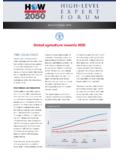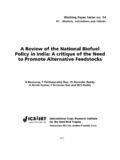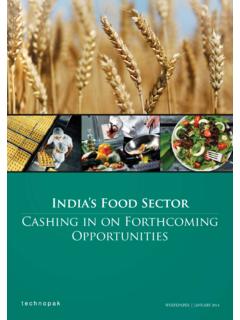Transcription of Advances in soybean processing and utilisation
1 Advances in soybean processing and utilisation Dr Bob Hosken University of Newcastle Introduction The cultivation and utilisation of soybeans originated in China more than 3000 years ago, and subsequently spread throughout the Orient. Soybeans are a good source of nutrients, as they contain around 40% of high quality protein, 20% oil, as well as a number of minerals, vitamins and phytochemicals. Today soymilk, tofu, yuba, and the fermented products natto, miso, tempeh and soy sauce continue to be important foods in Asian countries, however acceptance of the traditional Asian style soyfoods has been slow in western countries because of the beany flavour caused by lipoxygenases. Lui (1999) and Lui (2000) has reviewed soybean cultivation, processing and utilisation . It appears that soybeans had reached the United States (USA) by the mid-eighteenth century, however they were only grown in small amounts.
2 In the late 1920s, William J. Morse spent 2 years in China gathering more than 10,000 soybean varieties, and this work enabled more widespread cultivation of soybeans in the USA. Today, global production of soybeans is around 140 million metric tons, with around 50% grown in the USA, Other leading producers include Brazil, Argentina, China, and India. While a large proportion of soybeans grown in China, South Korea and Japan are used domestically for foods, most of the soybeans grown in the United States, Brazil and Argentina are traded on global commodity markets, with large sales to the European Union, China, Japan and Mexico. In western countries, soymilk is the most popular soyfood. In 1910, a patent for soymilk production was issued to Li Yu-ying, a Chinese living in France. Dr John Harvey Kellogg, an ardent vegetarian, and well known as the Director of the Batlle Creek Sanitarium and inventor of flaked breakfast cereals, developed a soymilk in 1920.
3 One of his students, Dr. Harry W. Miller (also known as the 'China Doctor' 1874-1977) took the Sanitarium concept and knowledge of soymilk with him to China, where in 1936 he began to reintroduce Asian people to a more palatable soymilk. Henry Ford was also an early soyfood advocate, and between 1934 and 1943, he entertained reporters at luncheons in which every course contained soybeans, from tomato juice with soybean sauce to soybean cookies and soybean candy for dessert. By 1935, his cars contained many components made from soybeans The western market for soyfoods is growing In Asia, modern soymilk plants were established during the 1950s by Mr K. S. Lo of Vitasoy in Hong Kong and Yeo Hiao Seng in Singapore. The main factor that has limited the use of soyfoods in western countries was the unacceptable taste of soybean products, which is strongly linked to the action of the lipoxygenase enzyme on the soybean oil.
4 When soybeans are hydrated and milled, the lipoxygenase breaks down the oil into a number of chemicals including hexanal, and these chemicals result in "off-flavours which are described as "beany", "painty", "rancid" or "bitter". During the late 1960s workers at Cornell University and the University of Illinois showed that heat could be used to reduce the action of lipoxygenase, so limiting the development of "off-flavours" produced in soy slurries. This knowledge, coupled with the development of UHT processing and aseptic packaging technology provided the platform for the expansion of the global soymilk market. Soyfood marketing research information is provided by a number or organisations including the United soybean Board (USB), Soyfoods Association of North America (SANA), and Peter Golbitz of Soytech, and some information is available at their web sites. Recent sales figures show that soyfood sales are one of the fastest growing sectors in the food industry, with growth of more than 15% per annum.
5 The USA sales and growth of western-style soyfood categories are presented in Table 1 Table 1 Sales of soy foods by category in USA 2001 Category $ Sales (millions) Growth rate (%) Soymilk 600 10-100% depending on form Meat analogues 450 14 Tofu 250 3 Breakfast cereals 160 Soy yoghurt 24 66 Frozen dessert 58 40 Soy cheese 58 12 Adapted from: Soyfoods: The Market 2002, speech presented by Peter Golbitz, Soyatech, at the 10th USB/SANA Soy Symposium, Chicago, IL, September 20, 2002. Australia produces around 50,000 ton of soybeans per years, which only meets around 50% of demand, so the balance of our soy-based feed and food needs must be imported. Over the last decade there has been a marked increase in the consumption of soyfoods in Australia, especially soymilk (Ginn et al 1998). Soymilk consumption in Australia is a little over 2L/capita/year. There are 3 kinds of soy beverage on the Australian market, first the Asian style soybean drink made from water, soybean extract and sugar; second are the natural or wholebean soy beverages; and the third group are the formulated soy beverages, typically made from soy protein isolate, vegetable oils with added minerals and vitamins.
6 Flavour can also be added. The beverages are marketed as either pasteurised fresh chilled products, typically in gable containers, or as shelf stable UHT/ aseptically packaged products. Given the limited production of soybeans in Australia, and the growth of the culinary market for soybeans, it is appropriate that farmers focus on producing value-added culinary soybeans for use in domestic and export markets. Australian soymilk producers include Sanitarium Health Food Company, Vitasoy and So Natural Foods. Many western consumers see soyfoods as being relatively expensive, and not having great sensory properties, however these factors are outweighed by the perceived health benefits. The perceived health benefits arising from consumption of soyfoods have included: good nutritional profile, a reduction in heart disease through reduced blood cholesterol, a reduced risk of cancer, control of menopausal symptons, weight control and longevity (Messina, 1999).
7 The health benefits are related to the protein, fibre and isoflavone content of soybeans (Messina, 1999). Sales of soyfoods was greatly stimulated when in 1999, the USA Food and Drug Administration approved a rule that allowed health claims to be included on labels of soyfoods, based on evidence that the consumption of 25g of soy protein per day can help in cholesterol reduction (Liu 2000). On the other hand, not everyone likes soyfoods. After expert sensory panel analysis of 7 brands of soymilk at the research agency of Arthur D. Little, the panel concluded that "Soy foods today simply do not meet consumer flavor expectations. The average consumer is not willing to trade taste for health benefits, no matter how great." The rapid growth of the soyfoods market is providing new opportunities for food companies, and this is reflected in the mission statement of White Wave (USA), which is "to fully integrate soyfoods into mainstream American diets" ( ).
8 Their pleasant tasting Silk soymilk has rapidly gained sales dominance in the North American soymilk market. They are not alone in their vision, for example Dupont and General Mills have established a joint venture to market their strikingly presented 8th Continent soymilk, while Sanitarium, an Australian Company have purchased Soyworld as a vehicle for manufacturing and marketing their "So Good" range of soy products in North America. Many of the well-known global food companies including Heinz, Kelloggs and Kraft have also taken steps to ensure a share of the expanding soyfoods market. The soyfood industry Farmers, grain merchants and related organisations are required to get soybeans to the farm gate, from whence they can be processed into value added animal feeds or soyfoods for human consumption. People in the soyfood production chain include: Farmers, grain merchants and related support organisations who get soybeans to the farm gate.
9 soybean processors who convert soybeans into value added ingredients including flour, oil, protein isolates, lecithin and animal foods. Processors include Cargills, Du Pont Protein Technology, Archer Daniel Midland. Soy food manufacturers who process soy ingredients into soy products eg Sanitarium manufactures soymilk and meat analogues, Vitasoy, Process and packaging engineers eg Tetra Pak, APV Flavour companies who provide soy flavour masking agents and flavours eg Wild, Firmenich Support organizations including government and industry regulators and researchers. This includes ANZFA, CSIRO, Food Australia, University researchers and marketing agencies. Designing new soyfood products Value adding to soybeans, and the growth of the soyfoods market, is dependent applying a wide range of knowledge and skill to designing and producing new soyfood products which better meet the needs of consumers. The steps involved in developing a new soyfood product are outlined below, and successful implementation of the process, can be measured in sales and profits, depends on effective and efficient management of each step of the process.
10 The steps involved in designing a new soyfood product are: Identify consumer needs and wants through marketing research. Design product concepts and develop prototype foods through interaction of consumers, marketers and technologists. Develop sensory and objective measures of quality through scientific and marketing research. Select soybeans and optimise trial process specifications using scientific research and engineering design (Kwok and Niranjan, 1995, Murphy, et al 1997). Evaluate prototypes using market testing, so as to scale up production. Economical use of by-products requires innovative thinking. Design and engineer product form and packaging. Packaging and labeling requires an understanding of consumer behavour and legislation. The investment of profits in growing the market requires management vision. Soyfoods are made mainly from soybeans or soy ingredients, and this is the unique attribute that defining this group of foods. In addition, various soyfoods have other specialised attributes that are designed to position them uniquely in the market place.






